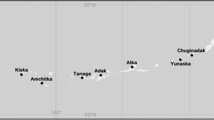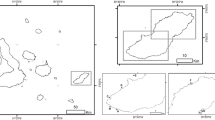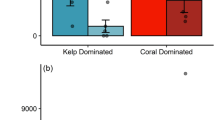Abstract
Tropical rocky shores have been described as diverse and having a complex variety of consumers. This wide array of consumers has been studied to shed light on the different roles of consumers, particularly grazers on rocky shores and how they affect the relative abundance and distribution of sessile algal prey. One of the aims of ecology is to clarify factors that regulate and structure the abundance, growth and relationship of predators and preys in each habitat. Grazing is known as one of the most important determinants of growth and distribution of rocky shore communities. In this study a comparison between the different effects of fishes, crabs and molluscan herbivores on the relative abundances of microalgae and macroalgae from micro (hundreds of microns) to medium (tens of meters to kilometers) scales of spatial variability was conducted. At the start of the experiment several hypotheses were forwarded: 1) that herbivores will reduce the density of microalgae and macroalgal cover causing a barren appearance and ultimately reducing algal diversity where grazing intensity is highest across treatments, sites and shores; 2) and where grazing pressure is low, algal cover and diversity will be high; 3) and that fishes and crabs contribute significantly to maintaining a high grazing pressure in the area and that fishes control the algal assemblage in benign environments. These were evaluated by exclusion experiments and quadrat counts to determine the effects of grazers on different functional groups of algae. Microalgal density was assessed indirectly by measuring chlorophyll a from rock chips taken from the treatment plots. Microspatial variability of different sites was assessed by scoring digital micrographs of rock chips also taken from treatment plots. Algal cover of treatment plots was assessed by using digital photos taken during forthnightly visits in all sites. The univariate and multivariate results show significant differences across treatments, sites and shores and even significant temporal differences. Microalgal abundance and erect algal cover in fenced plots were significantly different compared to the other treatments. Grazer removal effectively caused a completely different algal assemblage to develop through time in cage and fenced treatments while maintaining a mostly barren cover in most open and control set-ups. Species which are not typically present in shores have grown inside cage and fenced treatments during the period of manipulation. Molluscan herbivores are the most effective grazers in these shores and control the relative distribution of algae by restricting the recruitment success of algal sporelings particularly erect macroalgae. Herbivorous fishes and crabs do not directly influence algal sporelings since the early stages of algae are too small for them to handle. But both consumers complement the removal of turf forming algae. The observed over all grazing effects show that molluscs have greater impact than fishes and crabs combined; the effect of either fishes or crabs are equal. Hence, the impact of crabs and fishes on these shores are minimal, mainly affecting turf forming algae. Moreover, the observed spatial variability in algal assemblage from micro to medium scales is mainly driven by high grazing intensity. Thus, grazing acts as a highly effective top down control mechanism in these shores during the cool winter season.
Similar content being viewed by others
Article PDF
Author information
Authors and Affiliations
Corresponding author
Rights and permissions
About this article
Cite this article
Macusi, E. Variability and community organization in moderately exposed tropical rocky shore algal communities as influenced by different consumer groups. Nat Prec (2008). https://doi.org/10.1038/npre.2008.2267.1
Received:
Accepted:
Published:
DOI: https://doi.org/10.1038/npre.2008.2267.1



